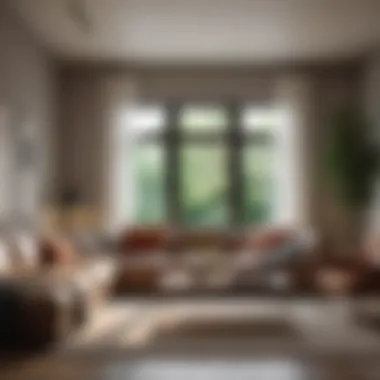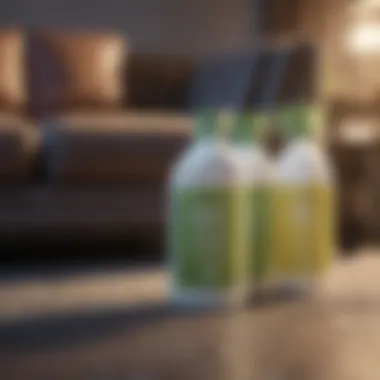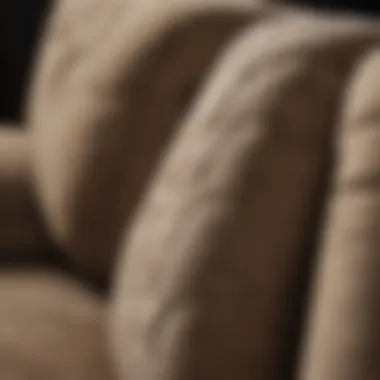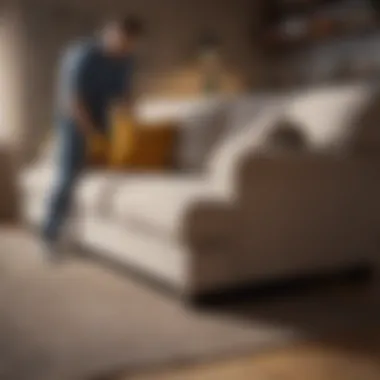Ultimate Guide to Sofa Cleaning Solutions


Intro
Sofas are often the centerpiece of a living room, serving both functional and aesthetic roles. They provide comfort and style, while also reflecting personal taste. However, maintaining a sofa to keep it looking fresh and new can be a challenge. Different materials require specific cleaning solutions and methods to avoid damage. Understanding the types of upholstery and their unique cleaning needs is essential. This article will navigate practical cleaning solutions tailored for various sofa fabrics, ranging from common materials like cotton and microfiber to more delicate options like leather and velvet.
Regular maintenance not only extends the life of a sofa but also enhances the overall atmosphere of your home. Stains and odors can diminish the appeal of even the most exquisite furniture. Homeowners, interior design enthusiasts, and party hosts will benefit from the insights provided here. From everyday cleaning methods to specialized products and DIY solutions, you will be equipped to tackle any challenge that comes your way.
Understanding Sofa Fabrics
The materials used in sofa upholstery significantly influence both the cleaning methods employed and the overall maintenance required for your furniture. Understanding sofa fabrics can enhance your ability to choose the right cleaning solutions, potentially prolonging the life of your investment. Thus, it is imperative to grasp the nuances of various upholstery types, including their durability, maintenance needs, and sensitivity to certain cleaning agents.
Natural Fabrics
Cotton
Cotton is a widely preferred choice for many homeowners due to its soft touch and breathability. It absorbs moisture effortlessly, making it comfortable. However, one must note that cotton is prone to staining. A spill can quickly lead to permanent marks if not attended to in good time. Cleaning cotton involves careful selection of mild detergents and avoidance of harsh chemicals.
Advantages of cotton include its resilience and ease of cleaning, while the main disadvantage lies in its vulnerability to discoloration and spills.
Linen
Linen serves as a sophisticated option for sofas, exuding an air of elegance. It is naturally hypoallergenic which makes it ideal for sensitive individuals. Its textured finish adds character to the furniture. Yet, linen can crease and stain more easily than other fabrics.
The main advantage of linen is its beautiful, natural luster, but it might require more frequent cleaning to maintain its appearance. Owners must be cautious during cleaning to avoid excessive wrinkling or damage.
Wool
Wool stands out for its durable nature. It offers excellent insulation, keeping warmth in during colder months. Its natural resistance to dirt is a significant advantage; most stains can be removed without elaborate cleaning methods. The downside, however, is that some individuals might be allergic to wool fibers.
In essence, wool provides a balance of comfort and functionality. However, caution is needed regarding its cleaning as some methods may damage the fabric.
Synthetic Fabrics
Polyester
Polyester is recognized for its strength and versatility. It is resistant to shrinking, fading, and wrinkling. Most cleaning methods can be applied without worry of damage. This fabric is popular among busy homeowners due to its durability.
However, polyester can be more susceptible to static and may not yield a cozy feel compared to natural counterparts. It remains a practical choice in sofa upholstery.
Nylon
Nylon is another popular synthetic option. It boasts remarkable resilience against abrasion and is less likely to break down under stress. One major benefit is that it maintains its texture over time. However, it can absorb oil stains, making special care necessary during cleaning.
In summary, nylon's advantages include its durability, but one must stay mindful of its cleaning challenges, especially with greasy substances.
Acrylic
Acrylic serves as a softer alternative to wool and is often used to mimic its texture. It is lightweight and easy to clean, advantageous for families with young children. Nevertheless, it does not perform as well under direct sunlight exposure and may fade.
Moreover, while acrylic provides an attractive appearance, it is essential to remain cautious about heat and direct sunlight exposure during maintenance.
Leather and Faux Leather
Real Leather
Real leather offers unmatched luxury and durability, a key factor for many homeowners. Cleaning real leather involves using specific leather conditioners and cleaners that preserve its finish. Care must be taken not to saturate the leather, as it can lead to rigidity or discoloration.
This fabric is certainly a high-end option. Its primary drawback is the potential for scratching and the need for regular conditioning to maintain its supple feel.


Bonded Leather
Bonded leather is often marketed as a more affordable choice. It is made from leather scraps bonded together, providing a leather-like appearance. While it is easier to care for compared to real leather, its longevity is generally lower. It can peel and crack with time.
This outcome means that bonded leather may require replacement sooner than other fabrics, making it a less durable option in contrast to traditional leather.
Vinyl
Vinyl offers a highly affordable and practical alternative to genuine leather. It is water-resistant and often easier to clean. One must note, however, that vinyl can be less breathable. With prolonged heat exposure, it can crack over time.
Using vinyl for upholstery is practical but might sacrifice some aesthetic appeal found in real leather. Thus, it serves well in casual settings or children’s environments.
Essential Cleaning Tools
Cleaning your sofa effectively requires more than just the right cleaning solutions. The tools you use can significantly affect the outcome of your efforts. Utilizing the appropriate cleaning tools makes the process efficient and ensures that you maintain the sofa’s appearance and longevity. Below, we will discuss some vital cleaning tools that any homeowner should consider when tackling sofa maintenance.
Vacuum Cleaners
Vacuum cleaners are essential for removing dust, dirt, and debris from the fabric of your sofa. Regular vacuuming not only keeps your sofa looking clean but also helps prevent allergens from accumulating. A vacuum with a brush attachment works well for this purpose, as it can reach into crevices and get rid of embedded particles. Ensure to use a vacuum cleaner that has strong suction power and capability to adjust for different fabric types. This can assist in preventing damage while still being effective.
Soft Brushes
Soft brushes are significant for delicate fabrics. They help in loosening dirt without damaging the fibers. A brush can get into spaces between cushions and gently remove dust. Using a soft brush can also be beneficial when dealing with pet hair. Always make sure that the bristles are soft enough not to scratch or snag the fabric. This tool is essential for maintaining a pristine appearance, especially if you have a sofa with intricate patterns or textures.
Microfiber Cloths
Microfiber cloths represent an invaluable addition to your cleaning toolkit. They are highly absorbent and effective for wiping spills and removing dust. Their fine fibers can capture dirt particles more efficiently than traditional cloths. When using these cloths, it is best to choose one that is not dyed or treated with chemicals, as these can sometimes interfere with the sofa fabric. Microfiber is also machine washable, making it easy to maintain.
Stain Remover Tools
Stain remover tools are a must-have for tackling specific stains that may arise on your sofa. These can include sprays designed to break down tough stains, like ink, coffee, or food. It’s important to select products that are safe for your sofa’s fabric; always read the labels. Additionally, having spot cleaning tools, like a small brush or a sponge, can assist in applying the cleaner effectively. Investing in the right stain remover tools will help maintain the sofa’s condition even in the face of challenging stains.
Key Insight: The right cleaning tools not only make cleaning easier but also prolong the life of your furniture.
Types of Cleaning Solutions
Cleaning solutions play a crucial role in maintaining the visual appeal and longevity of your sofa. This section explores various cleaning options, from commercial products to DIY solutions. Understanding these types will help homeowners select the most suitable method for their specific upholstery needs.
Commercial Upholstery Cleaners
Commercial upholstery cleaners are professionally formulated products designed to effectively clean various types of fabrics. They come in different forms, such as sprays, foams, and liquids, making it easy to apply them according to the requirements of the fabric. These products often contain detergents, solvents, and other cleaning agents that can tackle tough stains while being safe for most materials.
The benefits of using commercial cleaners include their efficiency in removing deep-set dirt and stains, as well as their convenience. For those who may not have the time or resources to create their own solutions, commercial cleaners offer a quick and effective way to refresh upholstery. However, it is essential to check fabric compatibility, as some commercial cleaners may not be suitable for delicate fabrics like silk or certain types of leather.
Homemade Cleaning Solutions
Homemade cleaning solutions provide a cost-effective alternative to commercial products. Many homeowners appreciate the simplicity and natural ingredients found in these DIY methods. This section elaborates on three popular homemade solutions:
Baking Soda and Vinegar
Baking soda and vinegar is a powerful duo in the realm of home cleaning. This combination is particularly adept at neutralizing odors and removing light stains. The key characteristic of this mixture lies in its chemical reaction; when combined, they produce carbon dioxide bubbles that can help lift dirt.
Baking soda is gentle on fabrics, making it a beneficial choice for various upholstery types. One unique feature is its ability to absorb odors, adding freshness to your sofa. However, care should be taken with colored fabrics, as vinegar may affect certain dyes, leading to potential discoloration.
Dish Soap Mixture
A mixture of dish soap and warm water can effectively tackle many common stains on upholstery. The key characteristic of this solution is its cleaning power without harsh chemicals. Dish soap cuts through grease and grime, making it a popular choice for removing food-related stains.


This mixture is simple to create, needing only a few drops of dish soap in water. Its unique feature lies in its availability, as most people already have dish soap at home. While generally safe for many fabrics, it is advisable to test on a small, hidden area first to avoid any adverse reactions.
Essential Oils
Essential oils can add both cleansing power and pleasant scents to your DIY cleaning arsenal. The specific aspect of this solution is its dual functionality - cleaning and providing fragrance. Oils like tea tree and lavender can help in odor removal and also offer antibacterial properties.
The key characteristic of essential oils is their natural origins, making them appealing for those looking to avoid synthetic chemicals. They can be mixed with other cleaners or used on their own diluted with water. However, it's important to note that some oils may stain certain fabrics, which is why testing is crucial before applying.
Step-by-Step Cleaning Process
In the realm of maintaining your sofa, following a structured cleaning process can yield significant benefits. Each step outlined in this section is designed to facilitate effective cleaning, ensuring that you not only remove stains and odors but also prolong the life of your upholstery. The methodical approach builds confidence and leaves no room for oversight, which can sometimes lead to larger fabric issues down the line. Careful planning can prevent damage to the sofa and help preserve its appearance.
Preparing the Area
Before diving into the cleaning process, it is crucial to prepare the surrounding area. This step includes removing any objects or furniture near the sofa. It allows unobstructed access to the sofa and prevents accidental damage during the cleaning process. Moving small items can easily be done, but larger furniture might need assistance. Consider laying down a protective covering on the floor to capture any dirt or drips that might occur.
Vacuuming the Sofa
Vacuuming is often considered the foundation of sofa cleaning. It removes loose dirt, pet hair, and crumbs that accumulate over time. To effectively vacuum the sofa, use a vacuum attachment that fits comfortably in the creases and corners. Pay attention to the fabric type; some fabrics might require a different approach to avoid damage. Vacuuming before applying any cleaning solutions helps to achieve better results, as it prepares the surface for deeper cleaning.
Testing Cleaning Solutions
It is essential to test cleaning solutions before applying them broadly. Each fabric type may react differently to various solutions, and testing in an inconspicuous area helps prevent unwanted damage. Apply a small amount of the chosen cleaner with a cloth, then observe for any adverse reactions over a few minutes. This step might seem tedious, but it is a prudent way to safeguard your investment.
Spot Cleaning Stains
When it comes to stains, timely intervention is key. Addressing stains promptly and effectively will significantly improve the overall appearance of your sofa.
Ink Stains
Ink stains are particularly vexing due to their potential to spread if not addressed quickly. They often originate from pens or markers and can be challenging to remove completely. The key characteristic of ink stains is their staining agents, which bond with fabric fibers. For this reason, utilizing an appropriate solvent, like rubbing alcohol, is recommended. It can break down the ink's properties, making it easier to blot away without damaging the fabric.
Food and Drink Stains
Food and drink stains encompass a wide variety of substances, from coffee to wine. Their commonality makes them a significant aspect of sofa maintenance. These stains can often leave behind residues that attract more dirt and accelerate fabric wear. You should focus on identifying the type of stain accurately. For example, a mixture of dish soap and water can effectively clean many stains without the need for harsh chemicals. Immediate action, such as dabbing with a cloth, helps lift the stain from the fabric without smearing.
Pet Stains
Pet stains present a unique challenge due to the organic nature of the stains and potential odors. Common sources include urine, vomit, or fur. The key characteristic of pet stains is their ability to penetrate deep into fabric fibers. As these stains can also cause lingering odors, it is crucial to treat them not just for appearance but for hygiene as well. Various enzyme-based cleaners are effective in breaking down these substances, neutralizing odors and preventing future incidents.
Deep Cleaning Techniques
Investing time in deep cleaning techniques can shift your cleaning efforts from surface level maintenance to thorough care. Depending on the fabric type, these methods might include steam cleaning or the use of specific upholstery cleaning machines. Always follow the cleaning guidelines specific to your sofa fabric to avoid any potential damage. Deep cleaning not only revitalizes the appearance of your sofa but also contributes to a healthier living environment.
Post-Cleaning Care
After cleaning your sofa, the post-cleaning care step is crucial. It ensures that the efforts put into cleaning are preserved over time. This stage involves two primary considerations: drying and protecting your sofa.
Proper care after cleaning can prolong the life of your furniture and maintain its appearance. If you skip this phase, the benefits of the cleaning process may diminish quickly. Hence, attention to details during this stage is necessary.
Drying and Aeration
It is essential to dry your sofa thoroughly after cleaning. Wet upholstery can lead to several issues, including mold growth and unpleasant odors. When transitioning from cleaning to drying, ensure that your sofa is in a well-ventilated area. If possible, open windows or turn on fans to enhance air circulation.
Allowing the fabric to breathe is beneficial. Doing so can help release moisture trapped within the fibers. Avoid covering your sofa with blankets or cushions before it is completely dry, as this will trap moisture and can worsen odors.
Protective Measures


Fabric Protectors
Fabric protectors are significant for maintaining the cleanliness of upholstery. These products serve as a barrier against dirt, spills, and stains. A notable characteristic of fabric protectors is their ability to repel liquids, giving you extra time to clean up before a stain sets in. They are popular among homeowners because they aid in preserving the sofa's original look. Their unique feature is their versatility; they can work on various fabrics, which makes them ideal for different styles of sofas.
However, while they are effective, fabric protectors may alter the texture or appearance of some materials slightly. It is wise to test any protector in a small, hidden area to ensure compatibility before full application.
Regular Maintenance Schedule
Establishing a regular maintenance schedule is vital for preserving your sofa in its best condition. This routine can includes simple tasks such as vacuuming, checking for stains, and applying specific cleaning agents as needed. A consistent cleaning schedule helps to prevent dirt buildup and prolongs the life of your furniture.
A key characteristic of this schedule is its preventative nature. Homeowners benefit because it reduces the necessity for aggressive cleaning measures later on. The unique feature is its adaptability; schedules can be tailored to fit individual lifestyles and sofa usage. However, it is crucial to find a balance to ensure that maintenance does not become overwhelming or tedious.
Keeping an eye on your sofa can save time and resources in the long run.
By integrating drying, protective measures, and a regular maintenance schedule into your sofa care strategy, you significantly enhance its durability and cleanliness.
Common Challenges in Sofa Cleaning
Cleaning a sofa presents unique challenges that necessitate attention and specialized approaches. Many homeowners encounter various issues, such as stubborn odors, fading colors, and allergic reactions caused by dust mites. Addressing these challenges is crucial for maintaining a comfortable and visually appealing living space. Understanding these obstacles not only aids in effective cleaning but also prolongs the lifespan of the furniture.
Dealing with Odors
Odors can become embedded in sofa fabrics due to spills, pets, and general use. Ignoring these odors can lead to an unpleasant living environment. To combat this issue, it is essential to identify the source of the smell. Simple solutions like baking soda can be sprinkled onto the fabric and left for a few hours to absorb the scent. Vacuuming afterward helps to remove the residue. Products like Febreze can also provide a quick fix but may not fully remove the odor-causing particles. Regular maintenance and cleaning can prevent odors from becoming a significant problem.
Fading Colors
Fading colors are a common issue, particularly for sofas that receive direct sunlight. Over time, exposure to UV rays can dull vibrant fabrics, leaving the sofa looking worn. To mitigate this, it is wise to rotate cushions periodically, ensuring even exposure to sunlight. Using window treatments, such as blinds or curtains, can also protect the sofa from harmful rays. If fading has already occurred, consider a fabric-safe color refresh product to restore vibrancy, although this should be approached with caution to avoid uneven results.
Allergies and Dust Mites
Allergies caused by dust mites are another serious concern. Sofas can harbor dust mites, along with other allergens like pet dander and pollen. Frequent vacuuming with a vacuum that has a HEPA filter is important to remove these irritants. Covering the sofa with slipcovers that can be washed regularly is also an effective preventive measure. If allergies persist despite cleaning, consulting with a healthcare professional is recommended to determine further steps that may be necessary for the household's health.
"Regular cleaning and appropriate storage are key in preventing severe issues like fading and odors, safeguarding comfort and aesthetics in your space."
By recognizing and addressing these common challenges in sofa cleaning, homeowners can create a more pleasant environment while ensuring their furniture remains in optimal condition.
Professional Cleaning Services
Professional cleaning services provide expertise and tools that can be critical in restoring and maintaining the condition of your sofa. Many homeowners might not realize the extent to which these services can enhance the look and longevity of their upholstery. The intricate nature of fabric types and their specific cleaning requirements often makes DIY efforts insufficient. By employing professionals, you tap into a wealth of knowledge and experience that is difficult to replicate at home.
When to Consider Professional Help
Certain situations warrant professional intervention. Consider professional cleaning services when:
- Severe Stains: If your sofa has stubborn stains that do not respond to homemade solutions, professionals have access to stronger, specialized products that can effectively tackle these issues without damaging the fabric.
- Odors: Persistent odors that linger despite your efforts may benefit from industrial-grade deodorizing treatments. These are particularly useful for sofas that have absorbed smells from pets or heavy use.
- Deep Cleaning Needs: Regular maintenance is essential, but over time, dirt and grime accumulate deeply within the fabric. A thorough deep clean can rejuvenate a sofa far beyond what surface cleaning achieves.
- Specific Fabric Care: Luxury fabrics, such as silk or designer upholstery, require particular care. Professional services understand the nuances of taking care of delicate materials.
Evaluating Service Providers
When selecting a professional cleaning service, it's essential to conduct a careful assessment. Here are important factors to consider:
- Experience and Reputation: Look for providers with a solid track record. Online reviews and testimonials can guide you to trustworthy services.
- Certifications: Check if the company holds industry certifications. This is often an indicator of training and expertise in dealing with upholstery cleaning.
- Service Range: Confirm that they offer services specific to your sofa's material. Not every service provider is experienced in all fabrics.
- Transparency in Pricing: A reputable service will provide a detailed quote beforehand. Avoid companies that only give vague estimates or those that offer drastically low prices, as they may cut corners.
- Customer Service: Initial contact with a provider can often tell you a lot. Are they responsive and willing to answer your questions? Good customer service can indicate a company that cares about its reputation.
The End
In the realm of upholstery and interior care, the conclusion serves as a critical synthesis of the various themes explored throughout this article. By revisiting the main points regarding sofa cleaning solutions—types of fabrics, essential tools, effective cleaning methods, and common challenges—homeowners can gain insights that are imperative for furniture maintenance.
Understanding the different fabrics and the specific cleaning solutions suitable for them is crucial. Each fabric, whether natural or synthetic, has unique properties that demand tailored care. Recognizing this diversity can prevent damage that may arise from using the wrong cleaning agents. Equally important is the knowledge of proper tools and cleaning techniques that ensure effectiveness without compromising the integrity of the sofa.
Furthermore, acknowledging the importance of regular cleaning can enhance the longevity of sofas. Prevention is often more effective than remedy. Homeowners who implement a maintenance schedule and utilize protective measures, such as fabric protectors, position their furniture to resist stains and odors more effectively.
Addressing common issues like fading colors and allergens is a vital takeaway from this discourse. These problems not only affect aesthetics but can also impact indoor air quality and personal comfort. Through adequate cleaning methods and environmental awareness, one can reduce allergens effectively.
While DIY solutions can be effective, there are instances where professional cleaning services are more suitable. It is essential to know when to seek out expert help to ensure that more complex issues are handled properly.
Consequently, this article emphasizes that sofa cleaning is not merely a task; it is an essential component of home care that contributes to a healthier living environment. Educating oneself about cleaning solutions equips homeowners with the necessary tools to maintain their furniture and, by extension, their homes. As a final note, it is wise to continuously stay informed about new techniques and products in the cleaning market to adapt to evolving needs.















